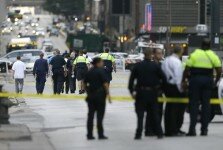Blaming the police when the security apparatus of a state fails is always a natural reaction. Soon after members of the National Democratic Front of Bodoland (IK Sonbijit faction) gunned down 71people, including women and children, angry residents have been complaining that not a single security personnel was visible on the ground as the militants went about their carnage. People were left to fend for themselves against the barrage of indiscriminate gunfire from automatic weapons. The police, however, say the terrain makes it difficult for them to operate with flexibility.

“You really have to understand the terrain. All these attacks happened on encroached lands. People have cut down trees in reserved forest areas and set up villages. It takes one and half hours of walking from the last motorable point to reach the spots. But we have already sought assistance from the army and they are planning on flag marches. We have also increased our patrolling extensively. We had input that there would be attacks but it was not specific enough. It is practically difficult to cover the entire area,” Sonitpur Superintendent of Police Sanjukta Parashar told Firstpost
She made it clear that the situation won’t become normal soon given the brutality of the massacre.
“The militants lined up women and children even less than a year old and shot them. We have enforced curfew in areas under five police stations of Rangapara, Missamari, Dhekiajuli, Biswanath Chariali and Sootea to prevent the situation from escalating. It will take a little longer to restore normalcy,” Parashar said.
The Centre also rushed in additional paramilitary troops. “We have already deployed the army. Curfew has been imposed in all the affected areas. Additional paramilitary forces have been rushed in from nearby states. The situation is under control now,” said Assam Inspector General of Police (Law and Order) SN Singh.
With memories of the 2012 conflicts still fresh, the state government is acting relatively fast in cases of ethnic flare-ups. The killings occurred on Tuesday evening but the worst fear was always of retaliatory attacks that started on Wednesday morning with the burning of over 150 houses in Bodo-dominated villages in Biswanath Chariali sub-division by Adivasis. The police were even forced to open fire on 2,000 Adivasi protesters armed with bows and arrows who surrounded the Dhekiajuli police station. The firing resulted in the death of three protesters and injuries to 15. Seven of the injured are stated to be critical.
The massacre started on Tuesday hours after Assam Chief Minister Tarun Gogoi said he doesn’t care about any threat by the NDFB(S) group. All these affected villages lack in basic infrastructure and are sparsely populated with one house located at a distance from another.
Despite the allegations of slow response, the state machinery is trying hard not to allow a 2012 type of situation. During the 2012 ethnic clashes in the same region between Bodos and allegedly migrant Muslims, the state government had failed to tighten security by timely deployment of armed forces in strategic areas, allowing the situation to escalate.
While the carnage by the NDFB(S) cadres is being viewed as a pure act of terror, policing has always remained an issue in these areas because of bad communication, inadequate deployment, terrain challenge and proximity to the state borders, which allows militants to escape easily. Although counter-terrorism operations are often carried out under the Unified Command structure which makes the army and paramilitary units part of the strike force along with the police, there are certain basic lacunae. One among them is the lack of night vision equipment to carry out missions after dusk. Ironically, Assam Police has a highly trained commando unit called the Black Panthers and its training standards are compared even with the National Security Guards. The state police also have personnel trained in jungle warfare.
It is doubtful whether Assam Chief Minister Tarun Gogoi, who has been heading the state home department till date for over a decade, has any road map for improving conditions on the ground. Arming police personnel with latest weapons is not the solution alone, fast mobilisation of forces is of significance as well. This is not first time that forces were at a disadvantage for similar reasons.
When Priya Basumatary, a class-X student from Runikhata Girls’ High School, was gunned down by NDFB(S) militants at Laimati–Dwimuguri village in the state’s Chirang district on 20 August this year the police faced similar problems. The monsoon was at its peak at that time and the security personnel had trouble recovering the body of the girl.
“As soon as we came to know about the murder, a joint team of police and army personnel went out in search of the body. It was raining too much and it was dark and so we could not locate the body. The team could not cross the rivers as all of them were in spate because of monsoon,” Chirang Superintendent of Police Ranjan Bhuyan had told Firstpost then.
“Night operation is tough because if we switch on torch lights we would become easy targets. Moreover, the area has a thick foliage growth of more than one-and-half feet height. These are not like normal villages. People have cut down jungles in reserved forest areas and built houses. The houses are scattered and are lying approximately 200 metres away from each other. The proximity of the area to Bhutan also allows the militants to hide in that country,” Bhuyan had said then.
It is astounding that while deploying forces in these areas the government has always sidelined the aspect of terrain and other miscellaneous equipment necessary for this kind of operations. During the rainy season, security forces struggle even more as they do not have boats to cross steams and rivers. Until the police are given all required gears to fight off militants, it would be little unkind to put the entire blame on them.





